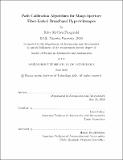| dc.contributor.advisor | Kerri Cahoy. | en_US |
| dc.contributor.author | Fitzgerald, Riley McCrea | en_US |
| dc.contributor.other | Massachusetts Institute of Technology. Department of Aeronautics and Astronautics. | en_US |
| dc.date.accessioned | 2018-11-28T15:25:22Z | |
| dc.date.available | 2018-11-28T15:25:22Z | |
| dc.date.copyright | 2018 | en_US |
| dc.date.issued | 2018 | en_US |
| dc.identifier.uri | http://hdl.handle.net/1721.1/119271 | |
| dc.description | Thesis: S.M., Massachusetts Institute of Technology, Department of Aeronautics and Astronautics, 2018. | en_US |
| dc.description | This electronic version was submitted by the student author. The certified thesis is available in the Institute Archives and Special Collections. | en_US |
| dc.description | Cataloged from PDF version of thesis. | en_US |
| dc.description | Includes bibliographical references (pages 131-133). | en_US |
| dc.description.abstract | The quest for increased resolution pushes telescope designs toward larger and larger apertures. This has motivated the development and expansion of distributed-aperture imaging. In radio wavelengths, distributed aperture signals can be recorded separately and correlated in software, but optical and infrared interferometry cannot currently use this approach because absolute phase must be captured. Instead, the beams from each sub-telescope must be brought together and interfered pairwise in order to measure relative phases and coherences, or "visibilities," by observing interference fringes. As the number of apertures increases, the number of pairs increases quadratically and pairwise fringe measurement becomes impractical. Direct-imaging interferometers instead combine all beams simultaneously by imaging the outputs onto a detector. Each aperture pair contributes a spatial frequency to the output, and the result is an image of the source instead of pairwise visibility information The densified-pupil direct-imaging interferometer, or hypertelescope, is a promising concept for future high-resolution imaging, both in space and on the ground; it offers the sharp resolution and efficient beam-combination of similar interferometric methods, but increases power in the PSF core through pupil densification. When implemented with single-mode fibers, the hypertelescope offers simplicity and the ability to expand to many-aperture configurations. However, broadband imaging requires that the optical path lengths all be matched to within a fraction of the wavelength. Telescopes of this type have been demonstrated, but generally rely on manual tuning of delay lines and air gaps in order to match the optical path lengths. This is not practically extensible to many-aperture configurations with hundreds or thousands of baselines, and is also difficult to implement in space, where a more automated procedure is required. Many methods for interferometer fiber length measurement have been developed, but most rely on extensive internal metrology or a specific calibration source, such as a polarized laser reference. Starting from the known concept of visibility phase sampling from the frequency-domain representation of a direct image, this work develops and characterizes a set of algorithms for the calibration of absolute path lengths in many-aperture fiber-linked hypertelescopes using only mis-calibrated images taken at a few wavelengths, enabling path-matched broadband imaging at high resolution. The unique baselines, fiber spatial filtering, and densified-pupil architecture of these telescopes enables these methods to be particularly effective, and a many-aperture configuration supports the inference of missing quantities of from the statistical properties of the apertures. An optimized frequency-sampling method extracts baseline phases from the miscalibrated image of a known source, and an efficient method for solving for aperture phases is presented. Observing and solving for the aperture phases at multiple wavelengths extends phase information into path length information using an expanded robust Chinese Remainder Theorem algorithm, and then the absolute offset and telescope pointing errors can be inferred from the statistics of the aperture path length errors. A simulation framework for fiber-linked densified-pupil direct-imaging interferometers is developed in order to test these algorithms and characterize the performance. A Fourier-domain signal-to-noise metric is derived, and ideal performance models for these algorithms are presented. The limits of performance are shown to be well-predicted by this metric and known properties of the telescope configuration. Finally, the simulation is used to characterize the effects of finite bandwidths, extended sources, optical aberrations, and pointing errors on the performance and robustness of these algorithms. Path lengths are shown to be measurable, inside a range determined by the calibration wavelengths, to within the required A/10 even in the presence of these non-idealities. | en_US |
| dc.description.statementofresponsibility | by Riley McCrea Fitzgerald. | en_US |
| dc.format.extent | 133 pages | en_US |
| dc.language.iso | eng | en_US |
| dc.publisher | Massachusetts Institute of Technology | en_US |
| dc.rights | MIT theses are protected by copyright. They may be viewed, downloaded, or printed from this source but further reproduction or distribution in any format is prohibited without written permission. | en_US |
| dc.rights.uri | http://dspace.mit.edu/handle/1721.1/7582 | en_US |
| dc.subject | Aeronautics and Astronautics. | en_US |
| dc.title | Path calibration algorithms for many-aperture fiber-linked broadband hypertelescopes | en_US |
| dc.type | Thesis | en_US |
| dc.description.degree | S.M. | en_US |
| dc.contributor.department | Massachusetts Institute of Technology. Department of Aeronautics and Astronautics | |
| dc.identifier.oclc | 1061859270 | en_US |
